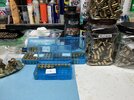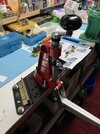nettlle
Contributing Member
You can look here:
 www.theballisticassistant.com
www.theballisticassistant.com
SAAMI Pistol Cartridge Catalog | The Ballistic Assistant
 www.theballisticassistant.com
www.theballisticassistant.com
 www.theballisticassistant.com
www.theballisticassistant.com
Well I haven’t decided what or whether I’m going to do but for sure if I had to go through what you described I wouldn’t add anything new. In fact I might be buying factory ammo vs reloadingI do sort 9mm by headstamp and I have sorted them by length, but it always took too much of my time so now I set up my Lyman M-die to flare the .740 and up, length cases, and when I get a shorter one, I won't be able to get a bullet to stick in the case while I'm loading.
I pull those cases off my LNL shell plate, which is easy, and set them aside for later to recover my primer, then they go in the recycle bucket. I don't get very many anymore. Maybe two or three per couple hundred, but in the beginning I threw some away for sure.
My seat and crimp dies are both micrometer dies so it's easy to make changes on the fly if I need to.
Yes, I have to de-prime some when I'm done but that doesn't take very long.
But it's much faster for me than sitting there with dial calipers and measuring each and every one. I realize I don't get the longer ones out (above .750) but I've never noticed any problems caused by them and don't want to become to OCD about them.
Once my dies were set up the way I wanted, finding the shorter ones now blends into the entire loading process instead of being a separate time-consuming step.
Just another way of doing the same thing.
I don’t know what that is but the win mag idea is so temptingi have contemplated making 45acp from shot out 06 or 08 brass. Never did it, but seems possible.
I remember your saga. I don’t have that issue so if I do measure, separate, and trim it’ll be hard for me to explain whyI too like to trim my .45acp and 9mm brass for a more uniform flare and crimp.
I do sort my brass and trim to the upper middle of SAAMI range and toss any short brass in the recycle bucket.
It just makes things go smoother. Aside from perhaps wasting a little of my time it hasn’t caused any problems.
Good point but since it’s pretty much a one and done exercise what’s to get tired of?Trim to your heart's content. It won't hurt anything, and in time, you will get tired of doing it, because it does not help anything either.
I never shot bottle neck pistol cases like the 38/40 or 44/40. Maybe they need to be trimmed just like bottle neck rifle brass.
I'm not sure I understand what you mean by "If I had to go through what you described". I bought the mic dies at 1/2 price. Like $50.00 each. My other dies worked fine. but I wanted to be able to have a reference point of how much I was changing the dies so I bought the mic dies.Well I haven’t decided what or whether I’m going to do but for sure if I had to go through what you described I wouldn’t add anything new. In fact I might be buying factory ammo vs reloading
Well in part it’s my reflexive reaction to anything progressive related. I’m a small volume shooter/reloader with a T-7 (glorified SS). No offense intended.I'm not sure I understand what you mean by "If I had to go through what you described". I bought the mic dies at 1/2 price. Like $50.00 each. My other dies worked fine. but I wanted to be able to have a reference point of how much I was changing the dies so I bought the mic dies.
As far as picking out the shorter cases by setting my M-die a little higher, that's just a lazy man's way of length sorting. If the bullet won't set in the case the case is to short for my crimp die so I pull it off the shell plate. Keeps me in a range of .740-.750 case length so my crimp die is in it's happy place. Easy Peezy.
YesBored?
All these fellers talking about saving time and shortening the reloading process… like they got other things to more important or something. Meanwhile Ol’ Glenn’s looking for ways to spend more time with his brass and press. I gotta say, there’s something to be said for not needing or wanting to be in a hurry.Bored?
Years ago....Trying to avoid shaving with LSWC and a 3 die set up on my Pro 1000, I made the mistake of trimming a big batch of 45ACP. After shooting them they measured about 0.887 which is 0.001 below SAMMI minimum (0.898-0.010). They have been that way a LONG time and do not appear to be getting any shorter. I am not too worried about it but it begs the question:Don't ... Do ... It.
Straight walled semi-auto pistol cases like 9mm and 45ACP that need to headspace off case mouth should not be trimmed as repeated resizing and firing will shorten the case length over time due to resizing die carbide ring not reaching all the way down to case base.
After too many reloadings, resized case length can get short enough to start headspacing off extractor as chambered round won't seat case mouth with chamber.
Cancel the order ... You will thank me later.
As close to SAAMI lengths, longer the better.
If you want consistency, sort by resized length but DO NOT TRIM.
SAAMI lists .754" for 9mm case length and for my Lee Pro 6000 and 2023 Pro 1000 finished OAL consistency testing, I measured resized case lengths and chose .750" as typical average length to set my case mouth flare amount and taper crimp die adjustment (As longer case will apply more flare/taper crimp but didn't find too many of those as shorter cases were more common) - https://www.thehighroad.org/index.p...r-oal-consistency.911743/page-3#post-12446468
By doing the "Plunk Test" for straight walled semi-auto pistol cases - https://www.shootingtimes.com/editorial/reloading-tips-the-plunk-test/99389How do you know if you are headspacing in the extractor when they "plop" fine and do not appear to drop in the chamber past the bevel of breech?
Another thing with using mixed range brass that can vary in resized case length; when I am setting up dies, I will measure resized case length of sample brass to identify "median/average" range of resized case lengths. When determining Max OAL, I will tend to use shorter resized case length as longer resized case length will allow less bullet nose/shoulder to protrude above the case mouth at the same OAL. (Using shorter resized case length to set flare/taper crimp amount will allow more flare/taper crimp with longer resized case lengths to help prevent shaved bullet, especially for seating/taper crimping in the same step, and skosh more taper crimp to not hang up flared case mouth with chamber wall).Years ago....Trying to avoid shaving with LSWC
Thanks for all the advice and opinions!By doing the "Plunk Test" for straight walled semi-auto pistol cases - https://www.shootingtimes.com/editorial/reloading-tips-the-plunk-test/99389
The "Plunk Test" is essentially checking these three things:
Here's comparison graphic from @Walkalong thread which illustrates all three items more clearly - https://www.thehighroad.org/index.p...rel-find-a-max-o-a-l-with-your-bullet.506678/
- Dummy round (No powder, no primer) or test/finished round's dimensions fit the chamber
- Bullet nose and shoulder do not hit the start of rifling
- Resized case length is not too long or short

When we perform the "Plunk Test", we are: 1) Checking to see if the dummy/test round falls into the chamber freely with a "plonk" (Hence the "Plunk" test) to verify round's dimensions do not exceed chamber dimensions, 2) Chambered round freely spin to verify bullet nose/shoulder do not contact the rifling and 3) Checking to see how high/low the case rim is relative to the barrel hood to verify resized case length.
Going right to left in the above graphic with A) through D) representing left to right labeling:
D) If dummy/test round drops in freely into chamber and spins without hitting the rifling, resized case length is too long and slide won't go into full battery as case rim protruding above barrel hood will prevent full lock up.
C) If dummy/test round drops in freely into chamber and spins without hitting the rifling, resized case length is headspacing off chamber and slide will go into full battery as case rim flush with barrel hood will allow full lock up (As indicated in the graphic, this will allow better sealing of gas as case mouth seals with chamber wall and produce improved accuracy).
B) If dummy/test round drops in freely into chamber and spins without hitting the rifling, resized case length is shorter than chamber to breech wall face distance and chambered round case rim can start to contact extractor to headspace off extractor (When powder is ignited, expansion of gas will push case rim against the breech wall face pushing case mouth away from the forward part of chamber, leaking more gas). If you use mixed range brass that's been reloaded multiple times, resized case length can vary quite a bit and neck tension/taper crimp amount could vary and addition of variance of gas leakage around case mouth all can tolerance stack to affect accuracy (Trimming case mouth to same resized length can improve flare/taper crimp amount consistency but won't improve gas leakage).
A) If dummy/test round drops in freely into chamber and spins without hitting the rifling, resized case length is so short that chambered round case rim is held back by extractor with case mouth dangling away from forward part of chamber to affect accuracy (It's like shooting 40S&W in 10mm barrel). When powder is ignited, expansion of gas will push case rim against the breech wall face pushing case mouth further away from forward part of chamber leaking more gas.
Another thing with using mixed range brass that can vary in resized case length; when I am setting up dies, I will measure resized case length of sample brass to identify "median/average" range of resized case lengths. When determining Max OAL, I will tend to use shorter resized case length as longer resized case length will allow less bullet nose/shoulder to protrude above the case mouth at the same OAL. (Using shorter resized case length to set flare/taper crimp amount will allow more flare/taper crimp with longer resized case lengths to help prevent shaved bullet, especially for seating/taper crimping in the same step, and skosh more taper crimp to not hang up flared case mouth with chamber wall).
If you are after utmost consistency, you can sort for same headstamp and same longer resized case length that will apply more consistent flare/taper crimp amount with more consistent finished OAL and more consistent neck tension/bullet setback - https://www.thehighroad.org/index.p...e-consistent-oal-on-progressive-press.921633/

Wisdom from the tropicsAll these fellers talking about saving time and shortening the reloading process… like they got other things to more important or something. Meanwhile Ol’ Glenn’s looking for ways to spend more time with his brass and press. I gotta say, there’s something to be said for not needing or wanting to be in a hurry.
Life is just too short to be in a hurry.
PM sentI don’t know what that is but the win mag idea is so tempting

That’s what I was hoping but it’s not easy—yet. Seems like you have to shave a little off to get chamfer to contact. But I’m not sure yet.Can you adjust the trimmer longer that the trim length so it would just chamfer ?
